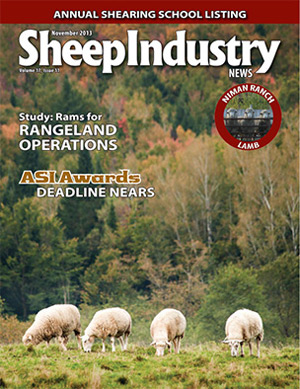
- November 2013
- President’s Notes
- Market Report
- Nov. 15 Deadline for ASI Awards
- Niman Ranch: Commitment to Quality
- Study: Terminal Sheep Breeds for Use in Western Range Operations
- Federally Inspected Lamb
- Immigrant Workers Needed by Many Sheep Producers
- Kott Retires after many Years of Service
- Shearing Contest in Michigan
- Weaving Wool into Scholarships
Immigrant Workers Needed by Many Sheep Producers
(Nov. 1 2013) America’s sheep industry isn’t among the segments of the country’s agricultural sector lobbying for new immigration laws as much as codifying its existing program in the proposed new legislation.
American Sheep Industry Association (ASI) Executive Director Peter Orwick said that over the past 50 years, America’s sheep producers have found ways to adapt to existing immigration laws. As the potential for immigration legislation reform hovers on the horizon, Orwick and his colleagues are making sure their legislators know that the industry needs to hang on to some of the directives now governing employment of foreign workers.
“Under the H-2A program, sheep producers have been able to maintain a legal work force,” Orwick said. “We had to find a way to make H-2A work for us when it was put in place in the 1950s. At that time, we found that Americans had no interest in working as sheepherders and foreign labor was our only resolution for that situation. Because sheepherders are needed year-round and the current law allows them to work on a three-year contract, the provisions of H-2A fit this industry’s immigration labor needs.”
Early in 2013, in consideration of the Border Security, Economic Opportunity and Immigration Modernization Act of 2013 (S. 744), Sen. Michael Enzi (R-Wyo.) spoke on the Senate floor in support of the special sheepherder provisions allowed to the sheep industry for more than 50 years.
“The special procedures play an important role in protecting the future of American agriculture,” Enzi said. “I am pleased the [proposed] immigration bill allows occupations such as sheepherding to operate under the new program as it has operated for the past 50 years. In addition, I am pleased that the legislation recognizes a specific need to address the unique wage, housing and operational components of the special procedure programs. Finally, it is vital that rulemaking requires agency consultation with stakeholders when drafting policies for the special procedure program.”
Special provisions in current immigration laws make it possible for sheep producers to abide by laws related to mobile housing, length of stay outside the United States and wage surveys.
“These special procedures are the reason why the H-2A program has worked so well for our industry for many years,” Orwick said. “ASI strongly supports legislation to codify these provisions to insure the H-2A program continues successfully for the nation’s lamb and wool producing farm and ranch families.”
Over 500 sheep operations, representing one-third of the nation’s sheep production, depend on foreign sheepherders for their operation. Over 2,500 herders, mostly coming from Peru, Chile and Mexico, work in the United States continuously.
The U.S. sheep industry has a $1.7 billion annual impact on the nation’s economy. Any negative impact on the industry would flow through to slaughter plants, wool warehouses and textile mills.
“Our industry doesn’t represent a large share of this country’s foreign work force,” Orwick said. “But we’ve probably been one of the most stable segments of foreign labor for many years. Recently, with all the publicity about illegal workers having a chance to get legal work papers after immigration reform, we’ve seen some foreign workers who have broken their contract and gone illegal thinking the penalties won’t be that severe. The drawn-out media coverage about immigration reform has had a negative impact on us.
“We don’t want the provisions we have to be lost in the rush for making immigration laws work for other parts of the ag industry,” Orwick said. “The proposed multi-year contracts for year-round workers that are of interest to dairy and livestock are similar to what sheep producers use today. One-third of the sheep industry is reliant on foreign labor resources. Losing the ability to bring them here in a timely and effective manner would devastate the lamb and wool business.”
The entirety of Enzi’s comments are available at www.sheepusa.org/ASI_Positions under the H-2A heading.
To read this article in its entirety, go to www.tsln.com/news/8196908-113/sheep-industry-immigration-orwick .
Reprinted in part from the
Tri-State Livestock News

